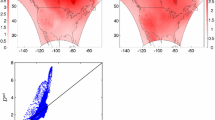Summary
Annual cyclone and anticyclone numbers in addition to the temperature data for the northern hemisphere are processed through simple models leading to meaningful interpretations. Historical climatological characteristics of the cyclone and anticyclone numbers are modeled by a first order Markov process. Statistically indistinguishable synthetic cyclone and anticyclone numbers are generated. Polygon diagrams which show the mutual relationships between average cyclone (anticyclone) numbers and the temperature are employed for finding possible relevant climatological changes during the record period. A polygon diagram concept is proposed and applied in order to identify sub-period warming and cooling spells of any desired short or long term durations and their relationship to the annual number of cyclone (anticyclone) occurrence numbers. The results indicate a decrease (increase) in the cyclone and anticyclone numbers during cooling (warming) periods. The methodologies proposed in this paper can be easily adopted for cyclone and anticyclone numbers modeling in any part of the world.
Similar content being viewed by others
Author information
Authors and Affiliations
Additional information
Received July 15, 1997 Revised January 22, 1999
Rights and permissions
About this article
Cite this article
Şen, Z., Kocçak, K. Markov Models and Polygon Diagrams for Climatological Interpretations of Cyclones and Anticyclones over the Northern Hemisphere. Theor Appl Climatol 63, 233–242 (1999). https://doi.org/10.1007/s007040050105
Issue Date:
DOI: https://doi.org/10.1007/s007040050105




